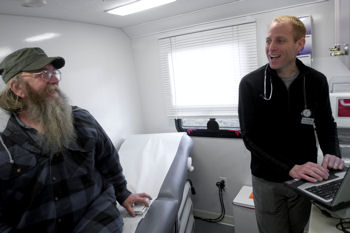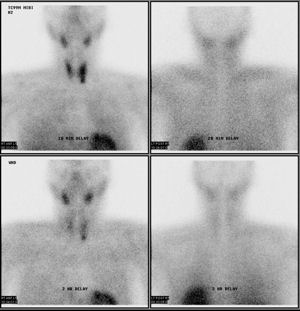The front office bottleneck: schedules, phones and refills
Third in a six-part series on small practice issues: ACP's Center for Practice Innovation found that about half of the practices it observed as part of its quality improvement project had problems with phone communication, scheduling and the prescription refill process. The good news is that the bottleneck can be loosened with some relatively simple changes.
When Georgia Newman, FACP, and her colleagues set up their general internal medicine practice in Oberlin, Ohio seven years ago, they thought they had a state-of-the-art phone system lined up. The office phone had multiple lines with voice mail, and the clinicians had portable phones for instant access. The set-up, Dr. Newman recalled thinking, “was really hot stuff.”

Alas, the portable phones were too heavy and interrupted patient care, so most of the doctors ended up leaving them in their offices. The nurses also refused to lug the phones around. And the multiple incoming lines didn't work out so well, either.
“It was basically ‘Oberlin Internal Medicine, please hold … please hold … please hold …,” Dr. Newman said. “You had patients standing at one window to check in, and at another window to check out. The secretaries were all on the phone, meaning the nurses and doctors couldn't call them to order things or to send patients here or there, so we'd have to walk to the desk and stand around until they were off the phone.”
The scenario isn't uncommon. ACP's Center for Practice Innovation (CPI) found that 47% of the practices it observed as part of its quality improvement project had problems with phone communication, while about 57% had scheduling problems and 55% had difficulty with the prescription refill process.
“In a small office, everyone at the front desk multi-tasks,” said Michael Barr, FACP, director of the CPI. “The problem is that, in meeting one set of demands, like checking in patients, another often suffers, like answering the phones. So the challenge is to manage the information flow at the front so that it doesn't become a bottleneck and limit the clinical team's ability to see patients.”
The good news is that that the bottleneck can be loosened. When the CPI visited those same practices about 10 months after the initial visits, it found marked improvement in all areas. Staff and patients were happier, too. All it took were some relatively simple changes to scheduling, phone systems and refill procedures.
Leave scheduling gaps
A poorly run schedule makes everyone in the office miserable, including patients, because it leads to long waiting times and rushed visits.
“In large studies on patient satisfaction, as in our research, one of the largest predicting factors of patient satisfaction is wait time,” said Will Underwood, a CPI senior associate who assessed practices during site visits and analyzed the results.
The first step in fixing scheduling problems is to be completely honest about how long appointments take. Many practices will schedule appointments every 15 minutes because they believe this will ensure productivity and financial success. In reality, many visits last longer, yet physicians tend to underestimate the number of visits that take longer than 15 minutes and overestimate the number that take less time.
“The best advice is to sit down and think about how much time you really spend with each patient, then use this assessment to create the patient schedule. If you still feel pressure to see more patients, try to analyze what is taking up your time during the visit, and then use that analysis to seek efficiencies,” Mr. Underwood said. “Trying to force a shorter appointment time, just to meet a predefined benchmark, will only lead to delays and increased waiting time.”
One simple way to address chronic logjams is to schedule catch-up times intermittently throughout the day: a five-minute gap between patients every two hours, for instance. This will short-circuit the escalating wait times patients experience as the day wears on.
David A. Burrows, FACP, a general internist in Castle Rock, Colo., has done this in his own practice.
“We have a half-hour period, from noon to 12:30 p.m., which I use to catch up. I notice the patients aren't so [aggressive] now that I'm not running behind as much,” Dr. Burrows said.
Each physician will have different preferences, but Mr. Underwood said he generally recommends scheduling several shorter catch-up times in the day, rather than one larger block of time.
“This way, you are not working through a 45-minute backlog at lunch, because you had that 45 minutes spaced out in the earlier part of the day,” he said.
Another way to cut down on delays is to leave spots in the schedule for same-day “sick visits” so they don't have to be squeezed into an already-booked schedule. Individual practices will need to evaluate how often they think they might need such open space. At the four-doctor practice of Jacqueline Fincher, FACP, a general internist in Thomson, Ga., one sick visit per hour seems to work fine, according to office manager Pam Shivers.
Keith Michl, FACP, a general internist in Manchester Center, Vt., says leaving unscheduled time for sick visits has actually improved revenue at his practice by drawing in patients he wasn't able to squeeze in before. Another helpful tactic has been to identify patients who usually skip appointments, and insist they call for appointments the same day they want to come in, he said.
“We identify frequent offenders and in some cases we actually charge people for not showing more than once in any given calendar year,” Dr. Michl said. “We also send extra emails to remind people of appointments we think they may forget, and warn that they will be charged for not showing.”
Some practices adopt the strategy of booking a reliable patient in the same time slot as a patient who usually doesn't show up. Obviously, this can create delays when both patients actually make their appointments. A better strategy is to double-book two unreliable patients in the same time slot, since the probability that both will show up is lower, Dr. Barr said.
In a practice where a specialist alternates between doing specialty and general internal medicine work, it's a good idea to schedule patients in blocks, Mr. Underwood added. A gastroenterologist, for example, could reserve two afternoons a week for his faster-paced internal medicine appointments, and schedule GI procedures back-to-back at another time, he said.
Overwhelming phone volume
Many CPI practices had an overwhelming volume of phone calls, which tended to divert workers from other tasks. Often the staff was acutely aware of the problem, but physicians were not, Mr. Underwood said. Dr. Newman was one such physician.
“My thought was ‘Well, that's [the front office's] job; they answer phones,’” Dr. Newman said. “I wasn't thinking maybe there would be a better way to do this than to have them sort out appointments, and do refills, and handle complaints, and do billings, and deal with hospitals and everything else, by themselves.”
A critical step to getting a handle on phone calls is knowing when the office's heaviest call times are. Typically, it's in the morning, Dr. Barr said.
“First thing in the morning, you will get calls from people not feeling well. Geriatric patients and mothers with children may call then. You will be dealing with people who reached on-call physicians the night before. On Fridays, there will be people who realize they need refills or that they will run out of medicine over the weekend,” Dr. Barr said. “You need a triage system at times like these.”
Having an automated phone system, which routes patients to different employees and to voice mail boxes designated for prescription refills, referrals or sick visits, can be a huge help. Practices can elect to use the system all the time, or turn it on only during busy times. They can also retain an option in the phone tree for reaching a live person, Dr. Barr said.
“With something like referrals, which aren't urgent, people will still call at 9 a.m. like everyone else. So a phone system helps offload these non-urgent issues, to allow the folks who really need it to get through to someone,” Dr. Barr said. “Then, during the down time, staff can handle those concerns that didn't need to be done right away.”
Many physicians resist using automated phone systems because they are concerned patients won't like them—such as Cecile Muehrcke, ACP Member, a general internist in Euclid, Ohio. She and her colleagues do have voice mailboxes, however, which has cut down on a lot of hassle, she said.
“In the past, there was a lot of time spent with the person up front putting the patient on hold and running back and forth trying to get the right person on the line,” Dr. Muehrcke said. “Now she can see from the phone if the nurse's line is busy, and offer to put the patient in voice mail on the spot.”
Improving your phone system can also result in better relationships and communication with referring physicians and consultants who may compete with your patients to get through busy phone lines. Consider establishing a “back line” for your colleagues to circumvent the phone queue, Dr. Barr recommended.
Patients are less averse to automated phone systems than most physicians think—in part because they are now so common in everyday life, Mr. Underwood said. In fact, at least one practice reported that patients were more satisfied after an automated system had been installed, because they could get through faster, Mr. Underwood said.
“I don't think anyone will leave your practice because you have a phone tree. In fact, patients are served better by them, because they help the staff feel less harassed, which means they are more willing to help patients and be pleasant when people walk into the office,” he said.
Reduce refill requests
Finding a better system for prescription refills was a critical component of updating Dr. Newman's front office operations, she said. Refill requests used to take about 30% of the front office staff's time, and patients often couldn't get through on the phone lines to make appointments as a result.
“A typical refill process would have the secretary taking the refill request—which was error prone, with patients spelling from the bottle—going to the chart room, finding the chart, writing a note to the doctor and documenting the refill, and waiting for the chart to be returned so she could call the pharmacy or the patient for clarification,” Dr. Newman said.
The office's first fix was to have notices in the waiting room and exam rooms reminding patients to bring in their refills, or at least a list of what they needed.
“That wasn't too successful. Not many complied, and those who did brought in bags with 20 bottles in it,” Dr. Newman said.
Dr. Fincher's practice also asks patients to bring their medications along at every visit to process refills on the spot, said Pam Shivers, the office manager.
“If you typically come back after three months, we'll refill for four months. So patients shouldn't need to call for refills … but people change appointments and doctors change appointments, which means patients do still end up calling and leaving a message for the nurse,” Ms. Shivers said.
Practices should have a standard checklist on hand to ensure staff members gather all pertinent information during refill phone calls, Mr. Underwood advised.
One innovative tactic Dr. Newman tried was to charge patients $7 every time a patient asked for refills between visits. It worked—and made the practice quite a bit of extra money—until one of the patient's HMOs called and told the practice it wasn't allowed to charge for this.
“So then we decided, for people with that HMO, they had to come into the office to get their refill, which of course meant they had to pay $10 now for a co-pay, instead of $7,” Dr. Newman said.
The final fix—and by far the most successful—was to simply have the patient call the pharmacy and tell them they needed a renewal of their prescription, then have the pharmacy fax the practice. This cut down on errors as well as time, Dr. Newman said.
“Most of our refills now come in by fax. I will either sign it electronically, or we'll print it up and fax it back. We don't do e-prescribing because we hear it doesn't work so well, and faxing seems to work just fine,” Dr. Newman said.
Dr. Michl also uses faxes with patients who fail to bring their prescriptions in during visits.
“We find that faxing, rather than having patients trying to pronounce these drugs, cuts way back on our phone time,” Dr. Michl said. “We've been doing it more and more over the last six months, especially after talking to other CPI practices that do it and hearing how much they like it.”




